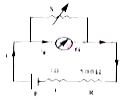A galvanometer has a sensitivity of 60 divisions A−1. When a shunt is used, its sensitivity becomes 10 divisions A−1. What is the value of shunt used, if the resistance of galvanometer is 20 ohm.Solution in Punjabi
Step by step video & image solution for A galvanometer has a sensitivity of 60 divisions A^-1. When a shunt is used, its sensitivity becomes 10 divisions A^-1. What is the value of shunt used, if the resistance of galvanometer is 20 ohm. by Physics experts to help you in doubts & scoring excellent marks in Class 12 exams.
Topper's Solved these Questions
Similar Questions
When is the force experienced by a current carrying conductor placed in a magnetic field, the largest?
02:41View SolutionShow that the path followed by a charged particle inside the electric field is parabolic in nature.
View SolutionWhat is electriG flux ? Explain how the electric flux through a surface is related to electric field intensity, when the surface is heldinside the electric field.
06:49View SolutionA galvanometer has a sensitivity of 60 division/ampere. When a shunt is used its sentivity becomes 10 divisions/ampere. What is the value of shunt used if the resistance of the galvanometer is 20Ω?
02:01View SolutionA galvanometer has a current sensitivity of 1 mA per division. A variable shunt is connected across the galvanometer and the combination is put in series with a resistance of 500Ω and cell of internal resistance 1Ω. It gives a deflection of 5 division for shunt of 5 ohm and 20 division for shunt of 25 ohm. The emf of cell is
05:44View SolutionA galvanometer has a current sensitivity of 5 divisions per milliampere and voltage sensitivity of 1 division per millivolt. The galvanometer has 30 divisions and it is to be used as an ammeter to read 6 A. This requires a shunt of value
04:07View SolutionThe sensitivity of a galvanometer is 60 division /A . When a shunt is used, its sensitivity becomes 10 division/A. If the galvanometer is of resistance 20Ω, the value of shunt used is
View SolutionThe Senstivity of a galvanometer is 60div/Ampere. When a shunt is used, its sensitivity becomes 10div/Ampere. If the resistance of the galvanometer is20Ω,then the value of the shunt used is
View SolutionThere is one moving coil galvanometer with coil resistance 25 Omega . Its current sensitivity changes from 72 divisions/ampere to 12 divisions/ampere when shunt is used. What is resistance of shunt is ohm?
View SolutionA galvanometer has a current sensitivity of 1mA per division. A variable shunt is connected across the galvanometer and the combination is put in series with a resistance of 500Ω and cell of internal resistance 0.5 Ω. It gives a deflection of 5 division for shunt of 5 ohm and 20 division for shunt of 25 ohm. Find the emf of cell and resistance of galvanometer.
 06:52View Solution
06:52View SolutionA galvanometer has resistance 500 ohm. It is shunted so that its sensitivity decreases by 100 times. Find the shunt resistance.
View SolutionThe sensitivity of a galvanometer is 60 divisions/Amp. When a shunt is used, its sensitivity becomes 10 divisions/amp. If galvanometer is of resistance 20Ω, · the value of shunt used is :
02:35View SolutionA galvanometer has a current sensitivity of 1 mA per division. A variable shunt is connected across the galvanometer and the combination is put in series with a resistance of 500Ω and cell of internal resistance 1Ω. It gives a deflection of 5 division for shunt of 5 ohm and 20 division for shunt of 25 ohm. The emf of cell is
04:12View SolutionA galvanometer has a resistance of 500 ohm. It is shunted so that its sensitivity decreases by 100 times. Find the shunt resistance.
View SolutionThe Senstivity of a galvanometer is 60"div"//Ampere . When a shunt is used, its sensitivity becomes 10"div"//Ampere . If the resistance of the galvanometer is 20 Omega ,then the value of the shunt used is
View SolutionA galvanometer has a current sensitivity of 5 divisions per milliampere and voltage sensitivity of 1 division per millivolt. The galvanometer has 30 divisions and it is to be used as an ammeter to read 6 A. This requires a shunt of value
02:17View Solution

